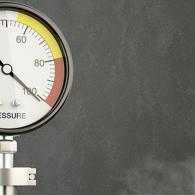The Cost of Lost Air
Food and beverage plants use compressed air for a wide variety of purposes including moving products, operating pneumatic tools or pumping liquids. Compressed air is a clean, reliable, accessible 4th utility which is often undervalued per unit compared to its other utility counterparts - water, gas and electricity.
Consider, for every eight horsepowers of electricity, only one horsepower of compressed air is generated. As a result, compressed air is one of the most expensive uses of energy in a manufacturing plant.
Understanding not only the financial value per unit of wasted air but the financial impact of a less reliable system requires a step-change in the perception of compressed air from being “free” to just as valuable as other utilities.
How Much Does Compressed Air Cost?
How is compressed air created? The Department of Energy (DOE) provides a simplified estimation of the cost of air using the direct components required to create compressed air: the size of the compressor, the time the compressors are on (control system - unload/load etc), the efficiency of the motor and operational hours.
| (hp) * (0.746 kW/hp) * (hr/yr) * ($/kWh) * (% time) * (% full-load bhp) |
| motor efficiency |
For example, a 100 hp compressor has an unload/load control system. The compressor is fully loaded 80% of the time and 20% unloaded. When running unloaded it runs 30% of the full load. The motor efficiency is 93%, the hours of operation is 5000 hours and the aggregate cost per kWh is $0.07/kWh.
One of the most expensive uses of energy in a manufacturing plant
Therefore, the full load cost is $22,460 and the unloaded cost is $1,684 with the total cost for one 100 HP compressor being $24,144. As most production plants have more than one compressor per site, and up to a third of compressed air is being lost to leaks, thousands of dollars worth of utility spend is leaking to the environment.
How the Compressed Air System can Impact Productivity
During food and beverage manufacturing, compressed air needs to be available at the required pressure to achieve production targets. Systems that are not regularly maintained after installation could be losing 20 to 30% of compressed air in leaks. Commonly, pressure drop is misdiagnosed as equipment failures, resulting in unnecessary capital investment in new compressors to increase capacity. In addition to lost production time from pressure drops, installing new equipment will also require equipment downtime and can impact planning schedules. With unplanned downtime costing on average $200 per minute, avoiding them is of utmost importance.
Better Compressed Air Stewardship
Better stewardship of compressed air systems and distribution of air can be achieved by:
- Identifying and eliminating areas of unnecessary use
- Identifying and repairing leaks in the system
- Regularly maintaining the distribution system
Eliminating Unnecessary Use
Similar to other resource conservation efforts the first step is to eliminate unnecessary use or replace with more efficient methods. For example, pneumatic tools could be replaced with electric tools.
Identifying Leaks
Large leaks with a decibel of >60 can be heard without any equipment; on other occasions, visual cues indicate that air is leaking. Some leaks can go unnoticed because the sounds blend in with the plant atmosphere and common surroundings. In many cases, the leaking air is not visible or audible to the human ear or is located at a point in the distribution system which is hard to reach, creating difficulties in finding the source and enabling a continuous waste of resource which could potentially cause production problems.
Our team utilizes ultrasonic equipment to “hear” leaks in the distribution system. The decibel output coupled with the application’s pressure is used as a method of quantifying the intensity of the leak and calculating the financial impact of each point of air loss. The data is then used to prioritize the maintenance schedule to see improvements in operating efficiency of both the compressed air system and the equipment using it.
Repairing Leaks
To achieve immediate improvements it is recommended that significant leaks are fixed as soon as possible and retested and validated.
Good Distribution System Maintenance
It is good practice to check for compressed air leaks at a bi-annual or quarterly frequency depending on the size of the production facility.
Optimization Tips for Compressed Air Systems
Once the distribution system has been validated as leak-free, further optimization can be achieved by addressing the following questions:
- Are Variable Speed Drives used?
- Would the system benefit from an additional receiver closer to the point of the applications?
- If there are multiple compressors, is there a sequencer that controls how each compressor works in the most optimal way?
- What does the actual distribution system look like? Is there looping / the ability to isolate and close a valve?
Diversey AirCheck
Compressed air/gas leaks are often overlooked in favour of more complex energy-saving solutions. With Diversey AirCheck, you can start and end with the confidence that your compressed air systems are not losing 20-30% of what is being produced to the atmosphere.







